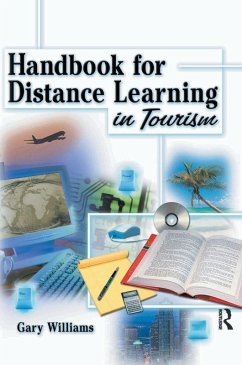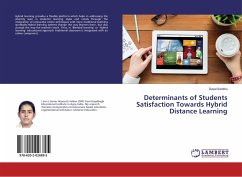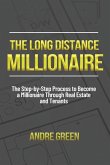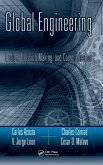Gary Williams
Handbook for Distance Learning in Tourism
Gary Williams
Handbook for Distance Learning in Tourism
- Gebundenes Buch
- Merkliste
- Auf die Merkliste
- Bewerten Bewerten
- Teilen
- Produkt teilen
- Produkterinnerung
- Produkterinnerung
The Handbook for Distance Learning in Tourism is a practical, down-to-earth guide to developing and using print-based and Internet-based flexible learning resources for courses where students rarely, if ever, attend on-campus classes. Whether you're a teacher who needs to develop course notes into a flexible learning package, a Web site, or both, or you just want information about how to teach in a flexible environment, the book will provide the help you needin language you can understand. Designed to guide you through the completion of a projector a semesterthis hands-on book offers…mehr
Andere Kunden interessierten sich auch für
![Exploring Distance in Leader-Follower Relationships Exploring Distance in Leader-Follower Relationships]() Exploring Distance in Leader-Follower Relationships179,99 €
Exploring Distance in Leader-Follower Relationships179,99 €![Managing at a Distance Managing at a Distance]() Tom CoughlanManaging at a Distance171,99 €
Tom CoughlanManaging at a Distance171,99 €![Determinants of Students Satisfaction Towards Hybrid Distance Learning Determinants of Students Satisfaction Towards Hybrid Distance Learning]() Dayal SandhuDeterminants of Students Satisfaction Towards Hybrid Distance Learning24,99 €
Dayal SandhuDeterminants of Students Satisfaction Towards Hybrid Distance Learning24,99 €![The Long Distance Millionaire The Long Distance Millionaire]() Andre GreenThe Long Distance Millionaire23,99 €
Andre GreenThe Long Distance Millionaire23,99 €![Web-Seek Monitoring For Distance Based Range Queries Web-Seek Monitoring For Distance Based Range Queries]() Rexie J A MWeb-Seek Monitoring For Distance Based Range Queries27,99 €
Rexie J A MWeb-Seek Monitoring For Distance Based Range Queries27,99 €![The Role of Psychic Distance on Outward Foreign Direct Investment The Role of Psychic Distance on Outward Foreign Direct Investment]() Joy AmgadThe Role of Psychic Distance on Outward Foreign Direct Investment27,99 €
Joy AmgadThe Role of Psychic Distance on Outward Foreign Direct Investment27,99 €![Global Engineering Global Engineering]() Carlos AcostaGlobal Engineering249,99 €
Carlos AcostaGlobal Engineering249,99 €-
-
-
The Handbook for Distance Learning in Tourism is a practical, down-to-earth guide to developing and using print-based and Internet-based flexible learning resources for courses where students rarely, if ever, attend on-campus classes. Whether you're a teacher who needs to develop course notes into a flexible learning package, a Web site, or both, or you just want information about how to teach in a flexible environment, the book will provide the help you needin language you can understand. Designed to guide you through the completion of a projector a semesterthis hands-on book offers strategies, suggestions, hints, and examples, and includes a hotel and tourism case study that illustrates effective concepts and strategies. To view an excerpt online, find the book in our QuickSearch catalog at www.HaworthPress.com.
Produktdetails
- Produktdetails
- Verlag: Routledge
- Seitenzahl: 268
- Erscheinungstermin: 27. Juli 2005
- Englisch
- Abmessung: 216mm x 153mm x 18mm
- Gewicht: 461g
- ISBN-13: 9780789018595
- ISBN-10: 0789018594
- Artikelnr.: 21304876
- Herstellerkennzeichnung
- Libri GmbH
- Europaallee 1
- 36244 Bad Hersfeld
- gpsr@libri.de
- Verlag: Routledge
- Seitenzahl: 268
- Erscheinungstermin: 27. Juli 2005
- Englisch
- Abmessung: 216mm x 153mm x 18mm
- Gewicht: 461g
- ISBN-13: 9780789018595
- ISBN-10: 0789018594
- Artikelnr.: 21304876
- Herstellerkennzeichnung
- Libri GmbH
- Europaallee 1
- 36244 Bad Hersfeld
- gpsr@libri.de
Kaye Sung Chon
* Preface
* Acknowledgments
* Chapter 1. Introduction to Flexible Learning and the Case Study
* Objectives
* Topic 1.1: What Is a Flexible Learning Environment?
* Topic 1.2: Maximizing the Return on Investment
* Topic 1.3: Introducing the Case Study
* Topic 1.4: The Development Model
* Key Points
* Chapter 2. The Project Manager
* Objectives
* Topic 2.1: Every Project Has a Manager
* Topic 2.2: The Role and Characteristics of a Project Manager
* Topic 2.3: Project Management Aids
* Topic 2.4: The Project As Organized Chaos
* Key Points
* Chapter 3. Starting a Project
* Objectives
* Topic 3.1: The Spark
* Topic 3.2: Developing and Buying Resources
* Topic 3.3: The Project Team
* Topic 3.4: Stakeholder Meetings
* Topic 3.5: Maximizing Project Ownership
* Topic 3.6: Considerations Before Committing to a ProjectA
Self-Appraisal for Teachers
* Key Points
* Chapter 4. Educational and Design Foundations
* Objectives
* Topic 4.1: Introduction
* Topic 4.2: ConstructivismA Theory of Knowledge
* Topic 4.3: Ensuring Quality Content
* Topic 4.4: Educational Design Guidelines for Learning Resources
* Topic 4.5: Writing a Course Outline
* Topic 4.6: Copyright
* Key Points
* Chapter 5. Media Foundations
* Objectives
* Topic 5.1: Introduction
* Topic 5.2: The Teacher Is Essential
* Topic 5.3: Determining the Needs, Wants, and Technology Access of
Students
* Topic 5.4: Secondary DeterminantsTeacher, Institution, and Course
Factors
* Topic 5.5: Using Media Instead of a Medium
* Key Points
* Chapter 6. Developing Print Resources
* Objectives
* Topic 6.1: Introduction
* Topic 6.2: Advantages and Disadvantages of Print Learning Resources
* Topic 6.3: Production
* Topic 6.4: Design
* Topic 6.5: Maintenance and Revision
* Key Points
* Chapter 7. Developing and Using Web Sites
* Objectives
* Topic 7.1: Introduction
* Topic 7.2: Advantages and Disadvantages of Web Sites
* Topic 7.3: Using the World Wide Web
* Topic 7.4: Production
* Topic 7.5: Design
* Topic 7.6: Maintenance and Revision
* Key Points
* Chapter 8. Computer-Mediated Contact
* Objectives
* Topic 8.1: Introduction
* Topic 8.2: The Advantages and Challenges of Computer-Mediated Contact
* Topic 8.3: Teachers' Roles
* Topic 8.4: Training and Support Roles
* Key Points
* Chapter 9. Course Management Systems
* Objectives
* Topic 9.1: Introduction
* Topic 9.2: The Advantages and Challenges of Course Management Systems
* Topic 9.3: A Teacher's PerspectiveUsing A Course Management System
* Topic 9.4: Training and Support Roles
* Key Points
* Chapter 10. Teaching in a Flexible Learning Environment
* Objectives
* Topic 10.1: Introduction
* Topic 10.2: Before a Course Starts
* Topic 10.3: The Start of a Course
* Topic 10.4: During a Course
* Topic 10.5: The Responsibilities of Educational Designers
* Key Points
* Chapter 11. Being a Student in a Flexible Learning Environment
* Objectives
* Topic 11.1: Introduction
* Topic 11.2: The Advantages and Challenges of Flexible Learning
* Topic 11.3: You Have Enrolled in a Flexible Learning CourseWhat Now?
* Topic 11.4: Making the Most of Learning Resources
* Key Points
* References
* Index
* Acknowledgments
* Chapter 1. Introduction to Flexible Learning and the Case Study
* Objectives
* Topic 1.1: What Is a Flexible Learning Environment?
* Topic 1.2: Maximizing the Return on Investment
* Topic 1.3: Introducing the Case Study
* Topic 1.4: The Development Model
* Key Points
* Chapter 2. The Project Manager
* Objectives
* Topic 2.1: Every Project Has a Manager
* Topic 2.2: The Role and Characteristics of a Project Manager
* Topic 2.3: Project Management Aids
* Topic 2.4: The Project As Organized Chaos
* Key Points
* Chapter 3. Starting a Project
* Objectives
* Topic 3.1: The Spark
* Topic 3.2: Developing and Buying Resources
* Topic 3.3: The Project Team
* Topic 3.4: Stakeholder Meetings
* Topic 3.5: Maximizing Project Ownership
* Topic 3.6: Considerations Before Committing to a ProjectA
Self-Appraisal for Teachers
* Key Points
* Chapter 4. Educational and Design Foundations
* Objectives
* Topic 4.1: Introduction
* Topic 4.2: ConstructivismA Theory of Knowledge
* Topic 4.3: Ensuring Quality Content
* Topic 4.4: Educational Design Guidelines for Learning Resources
* Topic 4.5: Writing a Course Outline
* Topic 4.6: Copyright
* Key Points
* Chapter 5. Media Foundations
* Objectives
* Topic 5.1: Introduction
* Topic 5.2: The Teacher Is Essential
* Topic 5.3: Determining the Needs, Wants, and Technology Access of
Students
* Topic 5.4: Secondary DeterminantsTeacher, Institution, and Course
Factors
* Topic 5.5: Using Media Instead of a Medium
* Key Points
* Chapter 6. Developing Print Resources
* Objectives
* Topic 6.1: Introduction
* Topic 6.2: Advantages and Disadvantages of Print Learning Resources
* Topic 6.3: Production
* Topic 6.4: Design
* Topic 6.5: Maintenance and Revision
* Key Points
* Chapter 7. Developing and Using Web Sites
* Objectives
* Topic 7.1: Introduction
* Topic 7.2: Advantages and Disadvantages of Web Sites
* Topic 7.3: Using the World Wide Web
* Topic 7.4: Production
* Topic 7.5: Design
* Topic 7.6: Maintenance and Revision
* Key Points
* Chapter 8. Computer-Mediated Contact
* Objectives
* Topic 8.1: Introduction
* Topic 8.2: The Advantages and Challenges of Computer-Mediated Contact
* Topic 8.3: Teachers' Roles
* Topic 8.4: Training and Support Roles
* Key Points
* Chapter 9. Course Management Systems
* Objectives
* Topic 9.1: Introduction
* Topic 9.2: The Advantages and Challenges of Course Management Systems
* Topic 9.3: A Teacher's PerspectiveUsing A Course Management System
* Topic 9.4: Training and Support Roles
* Key Points
* Chapter 10. Teaching in a Flexible Learning Environment
* Objectives
* Topic 10.1: Introduction
* Topic 10.2: Before a Course Starts
* Topic 10.3: The Start of a Course
* Topic 10.4: During a Course
* Topic 10.5: The Responsibilities of Educational Designers
* Key Points
* Chapter 11. Being a Student in a Flexible Learning Environment
* Objectives
* Topic 11.1: Introduction
* Topic 11.2: The Advantages and Challenges of Flexible Learning
* Topic 11.3: You Have Enrolled in a Flexible Learning CourseWhat Now?
* Topic 11.4: Making the Most of Learning Resources
* Key Points
* References
* Index
* Preface
* Acknowledgments
* Chapter 1. Introduction to Flexible Learning and the Case Study
* Objectives
* Topic 1.1: What Is a Flexible Learning Environment?
* Topic 1.2: Maximizing the Return on Investment
* Topic 1.3: Introducing the Case Study
* Topic 1.4: The Development Model
* Key Points
* Chapter 2. The Project Manager
* Objectives
* Topic 2.1: Every Project Has a Manager
* Topic 2.2: The Role and Characteristics of a Project Manager
* Topic 2.3: Project Management Aids
* Topic 2.4: The Project As Organized Chaos
* Key Points
* Chapter 3. Starting a Project
* Objectives
* Topic 3.1: The Spark
* Topic 3.2: Developing and Buying Resources
* Topic 3.3: The Project Team
* Topic 3.4: Stakeholder Meetings
* Topic 3.5: Maximizing Project Ownership
* Topic 3.6: Considerations Before Committing to a ProjectA
Self-Appraisal for Teachers
* Key Points
* Chapter 4. Educational and Design Foundations
* Objectives
* Topic 4.1: Introduction
* Topic 4.2: ConstructivismA Theory of Knowledge
* Topic 4.3: Ensuring Quality Content
* Topic 4.4: Educational Design Guidelines for Learning Resources
* Topic 4.5: Writing a Course Outline
* Topic 4.6: Copyright
* Key Points
* Chapter 5. Media Foundations
* Objectives
* Topic 5.1: Introduction
* Topic 5.2: The Teacher Is Essential
* Topic 5.3: Determining the Needs, Wants, and Technology Access of
Students
* Topic 5.4: Secondary DeterminantsTeacher, Institution, and Course
Factors
* Topic 5.5: Using Media Instead of a Medium
* Key Points
* Chapter 6. Developing Print Resources
* Objectives
* Topic 6.1: Introduction
* Topic 6.2: Advantages and Disadvantages of Print Learning Resources
* Topic 6.3: Production
* Topic 6.4: Design
* Topic 6.5: Maintenance and Revision
* Key Points
* Chapter 7. Developing and Using Web Sites
* Objectives
* Topic 7.1: Introduction
* Topic 7.2: Advantages and Disadvantages of Web Sites
* Topic 7.3: Using the World Wide Web
* Topic 7.4: Production
* Topic 7.5: Design
* Topic 7.6: Maintenance and Revision
* Key Points
* Chapter 8. Computer-Mediated Contact
* Objectives
* Topic 8.1: Introduction
* Topic 8.2: The Advantages and Challenges of Computer-Mediated Contact
* Topic 8.3: Teachers' Roles
* Topic 8.4: Training and Support Roles
* Key Points
* Chapter 9. Course Management Systems
* Objectives
* Topic 9.1: Introduction
* Topic 9.2: The Advantages and Challenges of Course Management Systems
* Topic 9.3: A Teacher's PerspectiveUsing A Course Management System
* Topic 9.4: Training and Support Roles
* Key Points
* Chapter 10. Teaching in a Flexible Learning Environment
* Objectives
* Topic 10.1: Introduction
* Topic 10.2: Before a Course Starts
* Topic 10.3: The Start of a Course
* Topic 10.4: During a Course
* Topic 10.5: The Responsibilities of Educational Designers
* Key Points
* Chapter 11. Being a Student in a Flexible Learning Environment
* Objectives
* Topic 11.1: Introduction
* Topic 11.2: The Advantages and Challenges of Flexible Learning
* Topic 11.3: You Have Enrolled in a Flexible Learning CourseWhat Now?
* Topic 11.4: Making the Most of Learning Resources
* Key Points
* References
* Index
* Acknowledgments
* Chapter 1. Introduction to Flexible Learning and the Case Study
* Objectives
* Topic 1.1: What Is a Flexible Learning Environment?
* Topic 1.2: Maximizing the Return on Investment
* Topic 1.3: Introducing the Case Study
* Topic 1.4: The Development Model
* Key Points
* Chapter 2. The Project Manager
* Objectives
* Topic 2.1: Every Project Has a Manager
* Topic 2.2: The Role and Characteristics of a Project Manager
* Topic 2.3: Project Management Aids
* Topic 2.4: The Project As Organized Chaos
* Key Points
* Chapter 3. Starting a Project
* Objectives
* Topic 3.1: The Spark
* Topic 3.2: Developing and Buying Resources
* Topic 3.3: The Project Team
* Topic 3.4: Stakeholder Meetings
* Topic 3.5: Maximizing Project Ownership
* Topic 3.6: Considerations Before Committing to a ProjectA
Self-Appraisal for Teachers
* Key Points
* Chapter 4. Educational and Design Foundations
* Objectives
* Topic 4.1: Introduction
* Topic 4.2: ConstructivismA Theory of Knowledge
* Topic 4.3: Ensuring Quality Content
* Topic 4.4: Educational Design Guidelines for Learning Resources
* Topic 4.5: Writing a Course Outline
* Topic 4.6: Copyright
* Key Points
* Chapter 5. Media Foundations
* Objectives
* Topic 5.1: Introduction
* Topic 5.2: The Teacher Is Essential
* Topic 5.3: Determining the Needs, Wants, and Technology Access of
Students
* Topic 5.4: Secondary DeterminantsTeacher, Institution, and Course
Factors
* Topic 5.5: Using Media Instead of a Medium
* Key Points
* Chapter 6. Developing Print Resources
* Objectives
* Topic 6.1: Introduction
* Topic 6.2: Advantages and Disadvantages of Print Learning Resources
* Topic 6.3: Production
* Topic 6.4: Design
* Topic 6.5: Maintenance and Revision
* Key Points
* Chapter 7. Developing and Using Web Sites
* Objectives
* Topic 7.1: Introduction
* Topic 7.2: Advantages and Disadvantages of Web Sites
* Topic 7.3: Using the World Wide Web
* Topic 7.4: Production
* Topic 7.5: Design
* Topic 7.6: Maintenance and Revision
* Key Points
* Chapter 8. Computer-Mediated Contact
* Objectives
* Topic 8.1: Introduction
* Topic 8.2: The Advantages and Challenges of Computer-Mediated Contact
* Topic 8.3: Teachers' Roles
* Topic 8.4: Training and Support Roles
* Key Points
* Chapter 9. Course Management Systems
* Objectives
* Topic 9.1: Introduction
* Topic 9.2: The Advantages and Challenges of Course Management Systems
* Topic 9.3: A Teacher's PerspectiveUsing A Course Management System
* Topic 9.4: Training and Support Roles
* Key Points
* Chapter 10. Teaching in a Flexible Learning Environment
* Objectives
* Topic 10.1: Introduction
* Topic 10.2: Before a Course Starts
* Topic 10.3: The Start of a Course
* Topic 10.4: During a Course
* Topic 10.5: The Responsibilities of Educational Designers
* Key Points
* Chapter 11. Being a Student in a Flexible Learning Environment
* Objectives
* Topic 11.1: Introduction
* Topic 11.2: The Advantages and Challenges of Flexible Learning
* Topic 11.3: You Have Enrolled in a Flexible Learning CourseWhat Now?
* Topic 11.4: Making the Most of Learning Resources
* Key Points
* References
* Index








